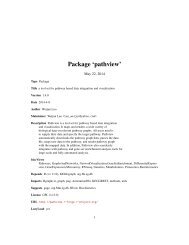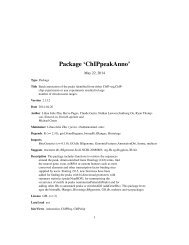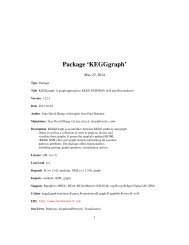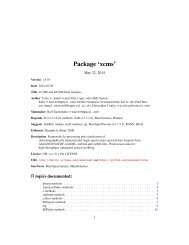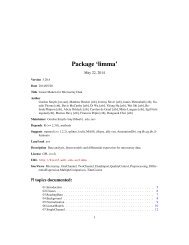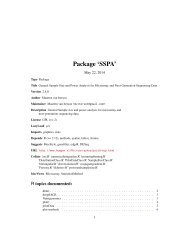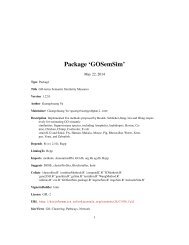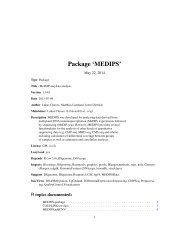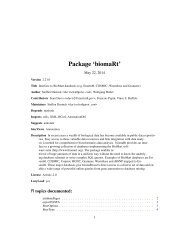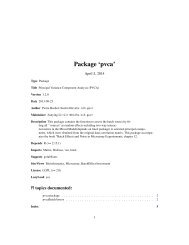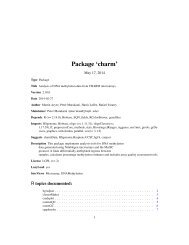Package 'metagenomeSeq' - Bioconductor
Package 'metagenomeSeq' - Bioconductor
Package 'metagenomeSeq' - Bioconductor
- No tags were found...
You also want an ePaper? Increase the reach of your titles
YUMPU automatically turns print PDFs into web optimized ePapers that Google loves.
30 MRexperimentMRexperimentClass "MRexperiment" – a modified eSet object for the data from highthroughputsequencing experimentsDescriptionThis is the main class for metagenomeSeq.Objects from the ClassExtendsObjects should be created with calls to newMRexperiment.Class eSet (package ’Biobase’), directly. Class VersionedBiobase (package ’Biobase’), by class"eSet", distance 2. Class Versioned (package ’Biobase’), by class "eSet", distance 3.MethodsNoteClass-specific methods.[,: Subset operation, taking two arguments and indexing the sample andvariable. Returns an MRexperiment object, including relevant metadata. Setting drop=TRUEgenerates an error. Subsetting the data, the experiment summary slot is repopulated and pDatais repopulated after calling factor (removing levels not present).Note: This is a summary for reference. For an explanation of the actual usage, see the vignette.MRexperiments are the main class in use by metagenomeSeq. The class extends eSet and providesadditional slots which are populated during the analysis pipeline.MRexperiment dataset are created with calls to newMRexperiment. MRexperiment datasets containraw count matrices (integers) accessible through MRcounts. Similarly, normalized count matricescan be accessed (following normalization) through MRcounts by calling norm=TRUE. Followingan analysis, a matrix of posterior probabilities for counts is accessible through posterior.probs.The normalization factors used in analysis can be recovered by normFactors, as can the librarysizes of samples (depths of coverage), libSize.Similarly to other RNASeq bioconductor packages available, the rows of the matrix correspondto a feature (be it OTU, species, gene, etc.) and each column an experimental sample. Pertinentclinical information and potential confounding factors are stored in the phenoData slot (accessedvia pData).To populate the various slots in an MRexperiment several functions are run. 1) cumNormStat calculatesthe proper percentile to calculate normalization factors. The cumNormStat slot is populated.2) cumNorm calculates the actual normalization factors using p = cumNormStat.Other functions will place subsequent matrices (normalized counts (cumNormMat), posterior probabilities(posterior.probs))



